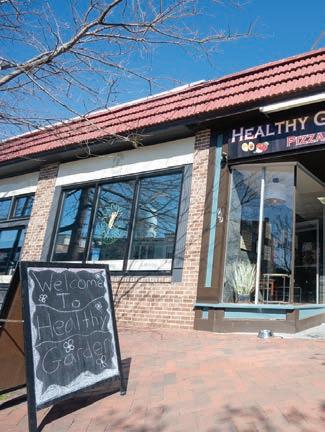




















Hello 08108! Spring is here! I am excited for you to check out our magazine dedicated to the lifestyle and community of Collingswood.


In this issue, readers will learn about the Chicken Lady of South Jersey, Gwenne Baile, also known as CEO and Chief Coop Cleaner for Camden County Chickens. She has been instrumental in helping communities like Collingswood create backyard chicken programs. Chickens, just like cats and dogs, have individual personalities, she says. They also eat those pesky insects and provide companionship, believe it or not! Learn all about chickens and the backyard chicken program starting on page 4.
Collingswood is leading by example in the state’s electric vehicle movement. New electric vehicle charging stations have opened at the public parking garage at the lumberyard, located at West Collings and North Atlantic avenues. Lindsay Ferguson, who serves as the director of community development for Collingswood, said the borough is also looking to switch its fleet vehicles to electric. Learn all about the electric vehicle craze starting on page 6.
The Collingswood Food Pantry –



powered by the goodwill of volunteers and clients alike - continues to serve those in need 25 years later. As Sue Merrill, current coordinator of the food pantry, puts it, “We like to think that what we do makes life a little easier for our clients.” All about their good work begins on page 8.
Looking for something different for your palate without the guilt? Try Healthy Garden Natural Food Café on Haddon Avenue. Len and Larissa Michnik, hailing from Ukraine, have filled a niche offering just that. Healthy Garden’s success lies in their variety, uniqueness, and customizable options. And, of course, their freshness. They cater to every different dietary desire there is. Eating to lose weight? Proteinbulking body builder? Hankering for international? They have something for you. Check them out starting on page 10.
It’s hard not to miss the rich history Collingswood brings when simply taking a stroll through the borough’s residential and commercial historic districts. We dive into each district and learn about the community efforts to help preserve the historical beauty of it all. Learn more starting on page 12. All of this and more awaits on the pages ahead!
Kathy Chang Managing Editor







 BY ELLEN KERSHNER
BY ELLEN KERSHNER
As a child growing up in Mt. Ephraim, Gwenne Baile had no experience with live chickens; she was a nurse for 40 years and a certified nurse-midwife for 28.
Far from live chickens.
Now, she is the CEO and Chief Coop Cleaner for Camden County Chickens. For her efforts and devotion, Baile has earned the title “Chicken Lady of South Jersey.”

When did Baile start showing an affinity for these friendly, finefeathered friends?





She was inspired by Martha Stewart, who handles live hens on TV. But after Baile discovered that having backyard hens was illegal in her hometown of Haddon Township, she took action. It took five years of studying local laws and working with the local
mayor and environmental commission to get things moving; the ordinance she helped create is designed to prevent environmental injustice and encourage food sovereignty. She has helped more than 28 communities update existing ordinances that restricted the number of chickens on residential properties – and she’s not done yet.
Camden County Chickens was created in 2015 and Baile continues to head the efforts. She also runs a therapy chicken program. That’s right: Not dogs, not cats, chickens.
“Chickens are very smart, she said. “I love working with them as therapy hens, particularly with special needs individuals.”
How do people act when they first meet a chicken, though? Scared? Curious? Excited?


“Everyone reacts differently,” Baile stated. “But most are curious and want to pet and hold the chickens.”

Gwenne’s therapy hens do not peck people, and are incredibly soft: each one has between 6,000 and 8,000 feathers. Kids love to feed them with the sunflower sprouts that she provides.



The Camden County Chickens program doesn’t require resi-












please see


page 5

dents to take a class before being licensed to raise hens (roosters are too loud), but certain towns do. Classes and training help communities, because well-cared-for chickens contribute to sustainability and don’t wander into neighbors’ yards. They also provide free organic eggs.
Donna Moffett chairs the Haddonfield Backyard Chicken Program and has worked with Baile.


“Just like cats and dogs, chickens have individual personalities,” she explained, adding that chickens also eat insects and provide companionship.
One of Moffett’s hens even plays a game with her dog. Moffett initially faced opposition to getting a backyard chicken ordinance passed in Haddonfield. It eventually passed in 2021.
This “Chicken Lady” points out that these programs “create a sense of community among hen owners, provide regulations and safety for the hens, and less fear and concern for residents.”
Emily Morgan is the chair of Voorhees Backyard Chickens. She started the program in 2020 and “was able to pass it easily with Gwenne’s help.”


Morgan is still trying to get one passed in Gibbsboro but has encountered roadblocks that “don’t seem to make sense.”






“We have had zero issues in Voorhees since we started the program and people love it,” she emphasized. “Unfortunately, the false narratives that surround a backyard hen program due to lack of education or personal interest keep it out of reach for some towns.”

The Chicken Lady of South Jersey’s Haddon Township program has gotten some publicity from local newspapers and TV stations and Baile hopes this might pave the way for more towns to pass chicken laws.
“I would love for it to be a true county program where all towns in Camden County, under county regulations, would allow backyard hens based on our program,” she said.



Moffett hopes that the Haddonfield program provides a positive experience for hen owners and residents. Participants have
enjoyed it and are very grateful, she said.

“It provides an educational experience for children, and shows them that bonds can be created between humans and other kinds of animals,” she said.
Morgan said she hopes “our proven strategy, leadership, and town support will make it an option for everyone in the area.”
“The great thing about this model is that we self-manage,” she said. “There’s no burden on the town and it becomes a small revenue stream for them. We perform inspections, require training before licensing, and handle any issues to ensure our program remains operational.”

Morgan adds that Baile does amazing work with therapy hens, and creates expo-


sure and training for the best practices. And fortunately, Baile’s not ready to stop doing what she loves yet – “all things chicken.” Baile is 74 years old and is “thrilled to have several younger protégés to continue the fight.”
She’s dedicated, passionate, and confident that her work will go on.

For more information visit https://www. camdencountychickens.org/


















Owning an electric car is a growing trend among Americans.



This new eco-friendly mode of transportation has driven up registrations by 60% in the first quarter of 2022, according to Experian data. Over the last five years, there has been a 250% increase of electric cars cruising around the country, making up 4.6% of total car purchases in the United States. It may not sound like much, but there’s a clear indication of a growing demand for electric cars. Regardless of the reason for one’s purchase, it is good to know
there is an option.



Collingswood residents who own or wish to own one of these vehicles can now charge up at one of the two new electric charging vehicle stations at the public parking garage at the lumberyard, located at West Collings and North Atlantic avenues.
While electric vehicles may still be a mystery to some, residents of Collingswood have a chance to learn about not only the future of green-friendly transportation, but how the charging process works for those vehicles.
Gov. Phil Murphy’s vision of 330,000 electric vehicles hitting Jersey streets by 2025 is in full swing. The green initiative, par-













please see CHARGE, page 15


About 25 years ago, the Saint Paul’s Lutheran Church in Collingswood started a weekly food donations table. Since then, this generous service has grown into a veritable food pantry that many locals depend upon. Bringing together the community through a mission of charity and kindness, the Collingswood Food Pantry serves many individuals and families each week.
Located down the street from Collingswood’s bustling downtown district of shops and restaurants lining Haddon Avenue, the Saint Paul’s Lutheran Church opens its doors for the food pantry every Tuesday and Thursday from 11 a.m. to 2 p.m. The pantry serves anyone in the greater Collingswood area, including towns such as Westmont, Haddon Township, Oaklyn, and Woodlynne.
Each visitor to the food pantry gets two whole bags of groceries, including fresh produce and cheese when available, and butter or margarine.
Visitors also have the opportunity to take one extra food item, such as coffee, juice, cookies, chips, or cake mix, as well as a non-food item, including household necessities such as deodorant, detergent, and cleaning supplies. Additionally, there can be give-aways on items such as peppers, salsa, and pet food, depending on what’s been donated.
“We like to think that what we do makes life a little easier for our clients,” says Sue Merrill, the current coordinator of the Collingswood Food Pantry. “Perhaps the money they save for groceries will help pay the rent. Some clients come only once or twice, just having lost a job. Some have come for years.”
No matter the reason, the Collingswood Food Pantry is there to help meet their essential needs. In February alone, the pantry served 712 people in 263 families.

Each month, the food pantry receives about 3,000 pounds of food from the Food Bank of South Jersey, a large grassroots nonprofit that also helps stock other local pantries in towns such as Camden, Pennsauken, and Cherry Hill.




According to Merrill, the Food Bank of South Jersey has “greatly enhanced our ability to bring meat, eggs and other foods to our clients. We also get donations from Holy Savior Roman Catholic Church, Holy Trinity Episcopal Church, community businesses, Collingswood schools, Boy Scouts, and many, many individual donations.”

All around, the food pantry is a team effort powered by goodwill – not just by the volunteers who work the food pantry, but also the clients who visit it.
On the first floor of the church, three to four volunteers work in the distribution room, handing out food and logging clients into the Food Bank of South Jersey website. On the second floor, individuals and groups of volunteers work to put food into bags, sort
please see PANTRY, page 9



PANTRY continued from page 8

reusable bags, and pack up cardboard boxes for recycling. Elderly volunteers also help out by placing tea bags within sandwich bags, to be included with clients’ groceries. What’s more, Merrill notes that “the clients are as generous as the donators, taking only what they need to be sure others also have what they need. Sometimes the clients bring in donations.”
Merrill has served as the Collingswood Food Pantry’s coordinator for three years now and has worked at the pantry since retiring nine years ago.



“The most rewarding aspect,” she says, “is the people. All of the volunteers, the folks







who drop off donations, and the clients.” The Collingswood Food Pantry is housed by Saint Paul’s Evangelical Lutheran Church, located at 832 Park Ave., Collingswood. Checks can be made payable to Saint Paul’s Food Pantry at that same postal address. Their phone number is (856) 240-7843. The food pantry is open every Tuesday and Thursday from 11 a.m. to 2 p.m., and serves Collingswood and the surrounding Westmont and Haddon Township, Oaklyn, and Woodlynne area.




















Healthy Garden Natural Food Café was always something different.

When rebels of the mid-20th century adopted vegetarianism and veganism, it sparked debates that turned a focus on the food industry. It caused a closer examination of supermarket meat, how it comes to us, and what it does to our bodies. This allowed for people, in turn, to realize that perhaps the food pyramid didn’t show the whole story. We began to understand that health con-

ditions can be avoided, and even remedied, by ingesting the right foods to avoid allergens and chemicals. When we mapped our unique selves, we learned that individuals processed foods differently.

For some restaurants, it hasn’t been the easiest to adapt. Making menus healthier means higher costs, more labor, and experimentation. Hence, the continuation to offer meat and potatoes, butter-laden sauces, and fried foods.

Enter Len and Larissa Michnik. Hailing from Ukraine, the computer programmer and his wife recognized the absence of dining choices for this new way of eating.
“When they opened the restaurant, there were not a lot of healthy options,” says James Lees, manager at the Collingswood Café location. “It was hard in the 80s, when they came over here. This was the first [healthy] place, and it’s way different. Not just salads, but a little bit of everything.”
Mark Mamedov said his aunt and uncle, who used to babysit him, essentially “came from nothing.”

“They spent endless days in the restaurant,” he said. “I remember they would have no food in the fridge at home because they would spend 14 to 15 hours a day in the restaurant, and then go home and sleep and come back in the morning. So, for them it was definitely hard. They’ve come a long way.”
Living the American Dream? Yes, according to Lees.
Healthy Garden’s success lies in their variety, uniqueness, and customizable options. And, of course, their freshness.
“Everything is made to order,” says Lees.




In addition to soups, sandwiches, and pizza, their “delectable sweet and savory
please see BITES, page 14
 PHOTOS BY N.J. ACKERMANN
PHOTOS BY N.J. ACKERMANN

Fresh food, healthy food, fast food, great vibe — all in one place. Mix and match, create your own, customize it. With all of this, Healthy Garden has achieved its mission to “prepare great tasting food that will leave you feeling energized and healthy.”






 BY MINDY TORAN
BY MINDY TORAN
In addition to its quaint downtown areas and robust shopping and restaurant scene, Collingswood has a rich history that can easily be identified by taking a stroll through the borough’s Residential and Commercial Historic Districts.


in
Listed on the State and National Registers of Historic Places in 1990, the Collingswood Residential and Commercial Historic Districts document a history of suburbanization, focusing on the transformation from farmland to community development and architectural advancement. The center of the borough is Knight Park, the 70-acre triangular farm field bordered by Park and Collings avenues and Browning Road. It is dedicated by Collingswood native, businessman, railroad executive and real estate developer Edward Collings (E.C.) Knight in 1888.
Knight grew up in what is now known as the Collings-Knight House on the corner of Collings Avenue and Browning Road, around which much of his Collingswood Land Company development was established. Knight’s grandfather, Richard T. Collings, purchased the original farmland along Haddonfield Road (now Haddon Avenue) owned by William P. Tatem, west of the Camden and Atlantic Railroad, and laid out streets and 171 lots that would ultimately lead to the development and establishment of the Borough of Collingswood. The borough’s proximity to Philadelphia and New York via train played a major role in its development into a residential complease see HISTORY, page 13

munity in the late 19th and early 20th century.
“The first development in Collingswood began after the railroads came through and allowed people to travel from the city to the suburbs,” says Keith Haberern, a historic architect and engineer who currently serves as chairman of the Collingswood Historic Preservation Commission. “These early homes and summer cottages provided a place for people to get out of Philadelphia, enjoy Knight Park and relax. One of the unique features of Collingswood’s historic district is that the homes encompass almost every architectural style in American history, including Colonial, Federal, Greek Revival, Victorian, Colonial Revival, American Foursquare, Arts and Crafts, and Modern.”
Collingswood was promoted as an idealized, planned town with generously laid out streets, residences of high architectural standards and landscapes of beautiful lawns and gardens. The area was advertised as a center for health and highlighted as a resort destination. The presence of the Cooper River and Newton Lake, along with Knight Park, enhanced the community’s recreational appeal. The majority of the homes included in the Collingswood Residential Historic District were built between 19001930, following the opening of a streetcar line along Haddon Avenue to Camden in the early 1900s.
As Collingswood’s appeal as a suburban refuge continued to grow, a commercial and social infrastructure began to take shape along Haddon Avenue, previously known as the Camden and Haddonfield Turnpike. In the 1860s and 1870s, most of the land that was to evolve into the commercial section of Haddon Avenue between Fern and Woodlawn Avenues was part of the 95-acre parcel owned by William P. Tatem. Much of the significant commercial growth of Collingswood did not occur until 1904, when Haddon Avenue was transformed into Collingswood’s commercial “main street,” supporting community development, employment and commerce.
“The homes and businesses included in Collingswood’s Residential and Commercial Historic Districts highlight the important historical significance and architectural features that are central to the town’s legacy and should be preserved,” says Haberern. “It’s one of the reasons that Collingswood has become such a popular destination spot these days. We have all of these buildings that are speaking to us from another era, that are important to preserve and not just be made into vinyl-sided boxes.”
In 1983, a group of Collingswood residents formed a civic association called the Proud Neighbors of Collingswood to promote awareness about historic preservation in the community, share ideas on restoration with residents, the business community and the local government, and work

to maintain the historic character of the borough. What started out as an outgrowth of a Collingswood Junior Women’s Club project focusing on the beautification of the Collingswood downtown business district led to forming a revitalization committee to promote Collingswood’s approved status on the local, state and national historic registers.
“Members of the Proud Neighbors of Collingswood would give walking tours of the community, highlighting areas of interest drawn up by George Palmer, who previously worked for the National Park Service,” says Ted Nickles, a contractor and former chair of the Collingswood Historic Preservation Commission. “The walking tours, which were made available through
(609)



the Collingswood Library, are a wonderful asset for people interested in the history of Collingswood and highlight the residences around Knight Park, along Park Avenue and along the main street and commercial district.”
Highlights of the historic district tour include the Gothic Revival home at 206 Collings Ave., home of Emma and William H. Collings, the superintendent of the

please see HISTORY, page 16
Top: 500 Collings Ave Collingswood NJ (Collings-Knight House). Right: Bungalow Colony along Collings Ave.
-
dishes that are prepared with the finest natural and organic ingredients” include platters, schnitzel, marsala, flatbreads, wings, quesadillas, ziti, stir-fry, crepes, and more. Also on the menu are 30 juices, plus smoothies. They are mixtures with a purpose. For instance: The Cure, Migraine Reliever, Flu Buster, Iron Booster and Cholesterol Reducer, each with ingredients to achieve their goals. If you prefer, they will custom-blend any juice choice on the spot.
“A lot of places will say freshly-squeezed juices, but they pre-make and then refrigerate them. We make it from scratch, upon request,” Lees says.
With an eight-page menu, Healthy Garden caters to every different dietary desire there is. Eating to lose weight? Protein-bulking body builder? Hankering for international? They have something for you.



“Flatbreads is our number one seller,” Lees says. “For vegan, look for the green ‘V’ or choose a dish and replace animal products; we have dairy-free Daiya. The falafel wrap and avocado star wrap are the best. Our gluten free bread holds together, it does. We have gluten free penne pasta also.”
For those on the go, order ahead and pick it up on the way to work or school. For discounts, set up meal or juicing plans. They do specials too. Their Superbowl giveaway was six free wings with a pizza.

Lees points out that Healthy Garden is not a corporation, but family run. And Mamedov says Len and Larissa are very hands-on, continuing to work hard on quality control, monitoring employees, and requesting experimental recipes from their chefs.
“Once tasted and approved, they will try it out as a special. If popular, it will be added to the menu,” Mamedov says.


For over 20 years, Len and Larissa have stayed on their mission, and now have three locations. Lees has worked for them nearly seven years. Other employees have been working with them since the very beginning.

“He’s like a father figure and she’s like a mom; they treat us like we’re their own kids,” Lees says. “They’re good people and a great team.”
Mamedov said his aunt was always a great cook. “This was her passion,” James noted.

The menu was designed and created by Larissa, and they both agree that her creativity is “through the roof.” She has definitely set their restaurant apart from the competition. They offer breakfast, lunch, dinner, delivery, catering, and take-out. Or, eat in their lovely BYOB (bring your own beverage) café of wood and stone. With smooth, bass music pumping in the background, there’s a cool, calm, trendy atmosphere with positive energy provided by the employees.
Fresh food, healthy food, fast food, great vibe — all in one place. Mix and match, create your own, customize it. With all of this, Healthy Garden has achieved its mission to
“prepare great tasting food that will leave you feeling energized and healthy.”
A passion? Yes, and it shows.

Fresh food, healthy food, fast food, great vibe — all in one place. Mix and match, create your own, customize it. With all of this, Healthy Garden has achieved its mission to “prepare great tasting food that will leave you feeling energized and healthy.”
tially funded by the New Jersey Department of Environmental Protection’s (NJDEP) It Pay$ to Plug In program, ensures the long-term goal of 100% clean energy by 2050.


“The program’s goal is to expand the electric vehicle infrastructure in Jersey,” said Lindsey Ferguson, who serves as the director of community development for Collingswood.
The purpose of the It Pay$ to Plug program is to “increase visitorship [to the state] too,” she added.












PSE&G, as well as the NJ Board of Public Utilities, have also provided additional funding to the electric charge stations at the current cost of $1.50 per hour for the first three hours and $3.00 per hour thereafter. Compared to the cheapest of gas prices, charging fees sound like the key to public appeal. Drivers can pay with the ChargePoint mobile app.
Level 2 chargers accommodate two types of cars. One — electric vehicles that run on batteries; these typically take four to 10 hours to charge from empty. Two — Plug-in Hybrid vehicles that take between one and two hours to charge. If you thought one to two hours was fast, wait until you get a load of the fast charger. According to Ferguson, “we have fast chargers coming to the Atlantic Avenue public parking lot. They can charge a vehicle up to 80% within 20 minutes to an hour,” she boosted.
As great as that sounds for drivers in a rush, that’s not the biggest news to hit Collingswood.
“The borough is looking to switch fleet vehicles to electric,” says Ferguson, moving Collingswood toward new greener pastures.
Plans to further the governor’s green energy agenda are not limited to the private sector.
“I think it’ll be the norm within five years,” Ferguson said with confidence.
The transition may just be inevitable if most states adopt a similar green initiative like New Jersey. In the meantime, Ferguson plans for Collingswood to lead by example. When asked if she ever saw herself purchasing an electric vehicle, her response — “I don’t have one [yet]...but plan on owning one!”
Electric vehicle owners and aspiring owners can pull up to the public parking garage at the lumberyard anytime of day. The charging stations are open 24/7.



E.C. Knight sugar factory in Philadelphia and younger brother of Richard T. Collings; the bungalow colony off of Allen Lane between Bettlewood and Colford avenues that included the home of developer H.L. Merrick; the old Collings Manor House, which became Merrick Villa; the CollingsKnight Homestead at the corner of Browning Road and Collings Avenue; and the First Methodist Episcopal Church (now United Methodist).
a volunteer effort called Main Street 2000 to paint and restore storefronts on Haddon Avenue. That was truly the beginning of the resurgence of Collingswood’s Commercial Historic District.”
Today, the homes and businesses that make up the Collingswood Residential and Commercial Districts serve as an important connection to the past and to the power of preservation promoted by members of the local community.




 BY JAMIE GIAMBRONE
BY JAMIE GIAMBRONE
Left: First United Methodist Church201 Dayton Ave. Right: 206 Collings Ave (Gothic Revival home)



“The commercial historic district provides a great example of a typical turn of the century and early 20th century business district which, while not architecturally significant, is historically significant and worth preserving,” says Nickles. “One individual who was instrumental in the resurgence of the commercial district was Joan Leonard, an occupational therapist, member of the Proud Neighbors of Collingswood and former borough commissioner who purchased and restored a historic home in town and spearheaded






The American Cancer Society Road To Recovery program gives cancer patients free transportation for cancer-related medical appointments. As a trained volunteer driver, you’ll join cancer patients on a crucial part of their journey to recovery, transporting them to and from their appointments and ensuring their access to care isn’t prevented or delayed because of lack of transportation. A few hours of your day could make a lifesaving difference. Connect with us to learn more about Road To Recovery volunteer opportunities in your area.
The American Cancer Society takes your safety seriously and has implemented new guidelines to minimize COVID-19 risks to patients and volunteer drivers. Volunteer drivers are required to certify that they are fully vaccinated and will continue to maintain that status during their service to the program. Visit cancer.org/drive Road To Recovery is a free program.








































“I like Tulips because they grow tall, they have great colors. They attract a lot of bees inside them, and sometimes you can find little mice sleeping inside of them. They are kind of like the beginning of spring and summer is right around the corner when they grow.”
“Daisies for sure. I’ve never liked Tulips very much; I don’t like the shape. I think Daisies are very pretty, they grow towards the Sun. I even have a little Daisy tattoo.”
“I like Daisies because my mom always grows them.”






“I like Tulips, because I associate them strongly with spring, it’s always a good sign seeing them because I know spring is around the corner.”


It’s all in the details. When it comes to your social calendar, change is … not always good. But sometimes it’s inevitable. In the event of cancellations and postponements, be sure to double check the status of the following events before attending.


Saturday 1: Brian Culbertson - The Trilogy Tour, Scottish Rite
7, 8: CHS PTA Egg My Yard
Saturday 8: Second Saturday
Saturday 15: Camden County Hazardous Waste Event
Thursday 20: Town Forum, Community Center




20, 21, 22: Get the Led Out, Scottish Rite
Saturday 22: Green Festival





28, 29: Yes featuring Jon Anderson, Scottish Rite
Sunday 30: Clover Market

Saturday, 6: First Farmers’ Market of the Season! Continues every Saturday until Thanksgiving
Friday, 12: The Temptations and The Four Tops, Scottish Rite
Saturday 13: Bike Rodeo
Saturday 13: 2nd Saturday

Saturday 27: May Fair
Roberts Pool Tag Sales/Season Begins: Date TBA
Saturday 3: Town Wide Yard Sale
Saturday 10: 2nd Saturday
Pride Events: Dates TBA

Juneteenth Event: Date TBA
Send us your calendar listings!
Please include all critical information: Who, what, where, when, and how to register or get tickets (if applicable), as well as a few lines of description. Email your listings to 08108@newspapermediagroup.com.




Since 1924 Inglesby & Sons has been the choice funeral service provider to Pennsauken and Merchantville families.


